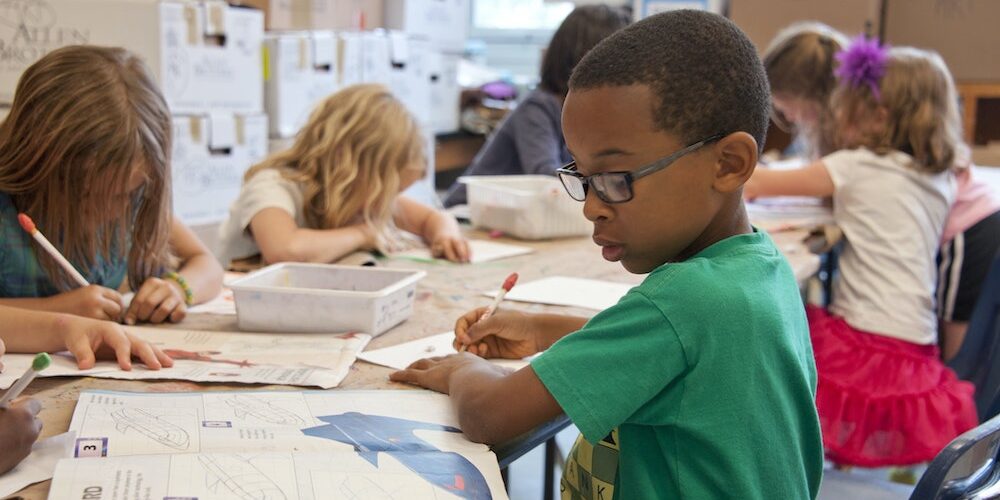Letting Go of the Status Quo to Put Students at the Center
By Brian Mumford
As I became interested in school choice while working on my doctorate in education, I never anticipated it being a third-rail topic. Whether discussing school choice as a parent, advocate, professional, or for academic work, I commonly receive one of three responses. There is exuberance (as if one Martian just found another), the polite “oh” followed by a pause and urgent switch of topic, and the rash “so, you hate public schools” retort. Unfortunately, the political for-or-against mentality that adults decide to associate with school choice has a consistent and obvious victim: the students.
Adults have a monopoly on education. We decide how students should learn, when they should learn, how they should learn, and which methods they will learn. We set the rules for which schools they can go to and what those schools are permitted to offer. Adults draw imaginary lines on a map and say, “here, but not there.” With so much adult power, why do our schools graduate students that adults believe are unprepared and unequipped for success?
Unfortunately, the political for-or-against mentality that adults decide to associate with school choice has a consistent and obvious victim: the students.
One reason might be that adults become preoccupied with power and control. We turn education into professional associations, teams of administrators, referendums, facilities, and performance statistics within adult paradigms. The students are simply at-level or not-at-level. As the caretakers of society, we adults need to be honest with ourselves. Do we like the status quo in education because it graduates students we complain about being ill-prepared for life, or do we like it because it creates an education-industrial complex—a place that allows adults to seek career progression and political scores under the guise of acting in the best interest of students?
Nowadays, the quintessential image of schools involves a labyrinth of buildings located on a sprawling campus that are towns or neighborhoods away from where most of the kids reside. Some students thrive and succeed in this environment, others learn the art of survival, and the rest seem to fade away. This system of education was my experience. I still have positive recollections of the teachers, administrators, and students; however, I recognized in middle school that the learning medium permitted by such an environment did not unlock my maximum learning potential.
The closest K-12 schooling came to maximizing my learning was offering a period in middle school called exploratory. It was a time when students chose an elective based upon interest or curiosity rather than academic pursuit. I learned more in those courses because I was driven by my own desire to acquire. There was no academic document telling me what I must know by the end of the course. Since that time, I have been convinced that a one-size-fits-all education created by adults is not in all learners’ best interest. Imagine what might be learned or created if the learner had more educational options available to them.
The experience I had as a K-12 student I am now witnessing as a parent. The district public school’s large corporate nature has become increasingly uninteresting and impersonal for my elementary-aged daughter. She speaks of tasks and assignments with the same amount of vigor that adults do: none. I am concerned that she is learning to hate learning. For alternative options, the community has a few small parochial schools and a charter school in the next town. By the numbers, each school is a quality option. However, each has an adult-driven learning approach. The lack of school choice leaves too many kids without a place or program in which they enjoy learning.
Whether students have access to school choice should not be based on what is best for adults. It is about recognizing the diversity of learners.
Whether students have access to school choice should not be based on what is best for adults. It is about recognizing the diversity of learners. Some learners can drive their own learning, while others do best with a very structured curriculum. Many fill the spectrum somewhere in-between. Some can thrive in a large public school, and others need a smaller setting. The role of adults in this process is to help guide students to a learning style and setting that works best for them. By supporting our students in this way, we may find that an education system driven by learners as opposed to adults may produce more prepared graduates than the ones we complain about today.
The politicization of school choice over the decades has developed policies and definitions created by adults. We should work to understand these constraints without being bound by them, so we can begin to explore what students need outside the conventions of adult thinking. This is not something that requires a blue-ribbon panel of professionals. It simply begins with humility. I don’t think like a child, and a child does not think like me. However, both perspectives are required to have an education system that maximizes learning and prepares students for life after graduation. We, adults, need to step away from the education-industrial complex that enshrines power over students. School choice needs to be a holistic, collaborative effort between young creatives and old pragmatics.
EdAllies seeks to elevate diverse voices and foster a candid dialogue about education. While we provide our blog as a platform for EdVoices and other guest contributors, the views and opinions they express are solely their own.

